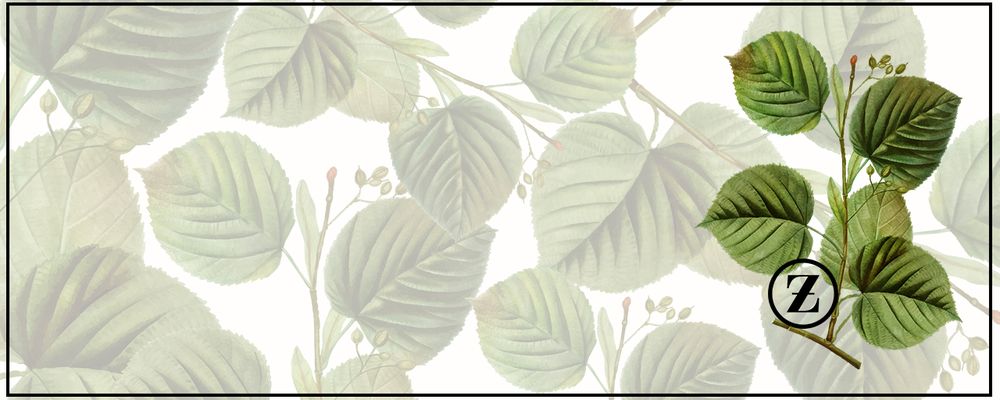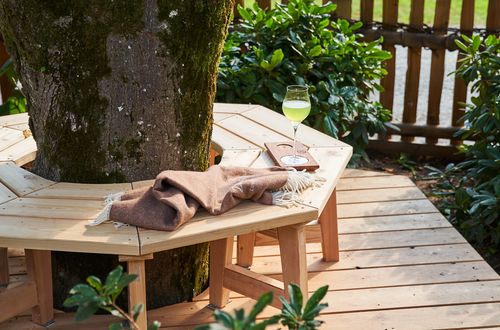The linden tree
The linden
The linden (Tilia) belongs to the Malvaceae family. Its leaves, which can be found in 2 rows, are heart-shaped with saw-tooth edges. The wood of the linden tree is soft. My husband Reinhard, an experienced wood expert, calls it as “stubborn”, which makes me smile. I refer to it by its strong character. Linden wood is not suited as construction timber, rather wood carvers, sculptors, and wood turners prefer to use it for their artistic creations. In earlier times, it was made into wonderful church altars.
One look at a splendid linden tree is a delight for both mind and body. Perhaps, this is why this wonderful plant has been so popular here for centuries. Whether as a site where assemblies and judicial court were held, as a provider of shade in the garden of the village inn, or as a beautiful ornamentation by the fountain at the gates: linden trees are mostly found in very symbolic places. After a war, lindens are planted as a symbol of peace. They are also affiliated with motherliness and are a symbol of love and gentleness. The magnificent fruits of the linden tree provide nectar and serve as honey plants for the bees. It’s a joy to watch as bees happily buzz around the sweet nectar. The linden blossoms also render us humans a service. A delicious tea can be prepared from these blossoms. Deeply rooted in folk medicine, the linden has a diaphoretic, cough-suppressing, antispasmodic, diuretic, and cleansing effect. It gently alleviates all kinds of aches and pains.
Contained within the flower buds is all important information the tree needs to grow. Inside is the embryonic plant tissues. This contains tannins, mucilage, saponins, flavonoids, essential oils, chlorophyll, ethylene, oligosaccharide (sugar), as well as phytohormones and phytoproteins. The exact ingredients vary depending on climate, location, amount of sunlight, and season. As soon as the sun has provided enough light and warmth to the buds, they begin to grow and open. This is the perfect time to harvest these little superheroes. Of course, you should always pick the buds with great respect and care. Only 1 bud should be taken from each branch so that the tree can continue to grow.
Please be sure to gather clean tree buds without any bird droppings or pests. The tree should be located away from busy streets. The linden buds are reddish and appear alternately on each side of the branch.
When you chew up the buds, the active ingredients within are released. You will notice the slightly sweet taste of the healing mucilage with its bitter aftertaste.
The best time and place to gather linden blossoms for tea is in a sunny spot in the late morning. You can pick the delicate buds, and the leaves are also suitable for harvesting. Be aware, because there will probably be bees. You can gather the blossoms in a basket or in a cloth bag and lay them out to dry. Don’t lay them to dry in direct sunlight. If you dry them in the oven, heat the oven to a maximum of 40 ° Celsius so as not to destroy the valuable active ingredients. After drying them, it is best to store them is in glasses or paper bags. Herbs do not do well in metal containers.
We like to drink linden blossom team as a warm infusion. With clean hands, we take as many linden blossoms as the index finger and thumb can grasp and fill a ceramic or glass sieve. For taste, we add an organic stick of cinnamon and pour boiling water over the linden blossoms. After ca. 6 minutes of infusing, we finish the tea by adding alpine rose or forest honey and freshly squeezed orange juice. The whole family will love this tasty drink.
For those suffering from a sore throat, we recommend cold linden blossom extract since the hot water will disintegrate the more delicate ingredients such as the mucilage. The dosage is the exact same for cold tea. However, the blossoms must be kept in a cool place for at least 2 hours. Since the mucilage can easily mildew, the cold extract must always be made fresh and immediately drunk.
Linden blossom tea is very mild, and people of all ages can enjoy several cups a day.
Linden bud-gemmotherapeutical macerate recipe
- 1 tablespoon (= 1 part) linden buds
- 3 tablespoons/parts water
- 3 tablespoons/parts glycerin from the pharmacy (85 % glycerol)
- 3 tablespoons/parts 40 % alcohol (grain, vodka)
Instructions:
Gently break or crush the buds with a mortar. Place in a sealable glass and pour the above-mentioned liquids over it. Let the macerate steep in a dark place for 3 to 5 weeks. It should be shaken regularly, preferably daily. The macerate will then be filtered and transferred to a dark bottle with a spray attachment or dropper attachment. The best way to ingest the macerate is through the mucous membranes. If you are uneasy or anxious, spray 2 squirts in your mouth. To feel the full effect, we recommend around 30 drops daily before mealtimes for 3 weeks.
For children, dissolve a few drops of the macerate in plenty of water and drink.
For legal reasons, we would like to point out: please clarify with your doctor beforehand if linden blossom tea and linden bud macerate is suited for you. You should not drink this tea if you are allergic to any ingredient. Recommendations are based purely on empirical values without medical background.


